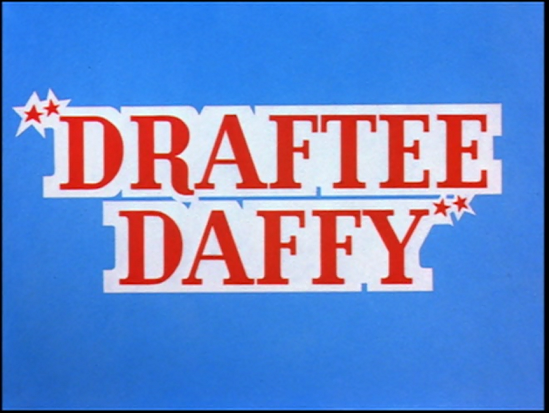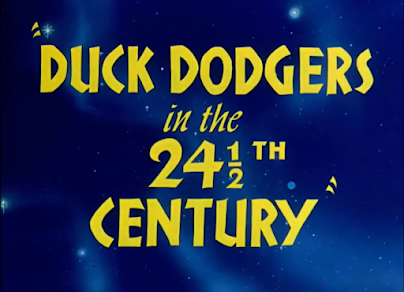Rod & Bob & Manny & Daffy
Nobody did manic energy like Bob Clampett, especially in his last few years at Warner Bros. And no cartoon did manic panic like Bob Clampett's Draftee Daffy (1945).
The story is a variation on the "escaped criminal" plot previously used by Tex Avery in Dumb-Hounded (1943) and later in Northwest Hounded Police (1946) - updated to be more World War 2-relevant (and probably more relatable to most of the contemporary audience). Daffy's gung-ho patriotic fervour turns to panic when he learns he's been called up by "the Little Man from the Draft Board."
While Avery's escaped jail-wolf travelled all over the world in his attempt to escape the Long (and calmly stoic) Arm of the Law, Daffy spends most of the cartoon just trying to escape his house. But any restrictions in the setting are made up for by Daffy's performance - that is, the combined performance of voice actor Mel Blanc and the animators.
I posted before about how fascinated I was by the way that the talents of multiple animators combine to create a single performance. It's even more interesting when you can visually identify the work of the different animators... and it still creates a single performance.
While Avery's escaped jail-wolf travelled all over the world in his attempt to escape the Long (and calmly stoic) Arm of the Law, Daffy spends most of the cartoon just trying to escape his house. But any restrictions in the setting are made up for by Daffy's performance - that is, the combined performance of voice actor Mel Blanc and the animators.
I posted before about how fascinated I was by the way that the talents of multiple animators combine to create a single performance. It's even more interesting when you can visually identify the work of the different animators... and it still creates a single performance.
These scenes of Daffy looking out the window and seeing the Little Man standing outside were animated by Rod Scribner. He conveys Daffy's emotions through physical distortions - his body squashes, stretches and bends around, his eyes bulge out, the hairs/feathers on his top-knot extend and stand on end... as animated by Scribner, Daffy isn't just figuratively mercurial, he literally has the qualities of mercury, the liquid metal also called quicksilver. And because of Scribner's highly detailed drawings - characters form wrinkles as they contort their faces and bodies - the shape changes, ridiculous as they are, look like they could be physically possible.
By contrast, this later scene was animated by Bob McKimson, who was great at drawing characters with real visual appeal. His Daffy is much more solid-looking - his proportions never change, no matter how extreme his emotions are, and he only moves his body in realistic ways (for a human).
If Scribner and McKimson had been the only two animators working on this cartoon, Daffy might have looked like two separate characters depending on which scene he was in. But there were at least two other animators involved, one of whom did my favourite part of animated acting in the whole thing:
If Scribner and McKimson had been the only two animators working on this cartoon, Daffy might have looked like two separate characters depending on which scene he was in. But there were at least two other animators involved, one of whom did my favourite part of animated acting in the whole thing:
Daffy's initial reaction to getting called up was animated by Manny Gould. His style could be described as combining McKimson's appeal with Scribner's exaggeration, but also expressing neither quality in the same way as those other two animators (you might see where I'm going with this).
His exaggeration comes less from changing the characters' shapes, but from giving them wild gestures and making them emote right into the "camera", though sometimes he does have their arms stretch beyond usual length, or make their mouths become extra large and wide. His Daffy, while closer in appearance to McKimson's than Scribner's, is smaller and skinnier, with an elliptical head and eyes. Unlike any of the other animators on this cartoon, he gave Daffy flexible noodle arms, with no discernible feathers.
Unfortunately, no animator draft (uh... no pun intended) survives for this cartoon, unless it's in a private collection somewhere. At least there are publicly available copies for other cartoons which these animators worked on, including the first half of Bob Clampett's A Gruesome Twosome (1945), released a few months later and probably with the same team of animators (studied here at CartoonResearch.com). Therefore, all animator attributions made in this post were based on detective work carried out by other cartoon fans/historians.
In some cases, these other "detectives" have *disagreed* about who animated certain scenes in the cartoon: the scenes I highlighted are among those everyone agrees on. The fact that this is possible shows how much, despite their own unique qualities, there was enough overlap between the animators' styles that some scenes are difficult to determine who animated. They do seem to have been capable of picking up techniques from each other (possibly at director Bob Clampett's suggestion) - in the following year's Baby Bottleneck (1946), Rod Scribner gives Daffy the noodle arms that Manny Gould gave him in Draftee Daffy.
What can we learn from all this? In times of extreme emotional stress, sometimes you can be a McKimson, sometimes a Scribner, and sometimes a Gould, but always a Daffy.







I'm a Melendez fan more than any of these guys. Jim Tyer is my favorite wacky animator. Favorite animator ever? Bill Nolan or Milt Kahl.
ReplyDeleteI'm probably your new frequent commenter (I saw your link on Cartoon Research). I hope you'll be one of mine!
Actually, not Kahl. Frank Thomas!
DeleteI really like Bill Melendez's animation as well, and was considering doing a post on the animators of "What Makes Daffy Duck" instead, but I felt that McKimson-Scribner-Gould made a better comparison, as the similarities and differences within their styles could all contribute to a unified character.
Delete